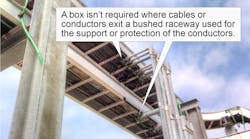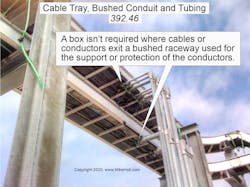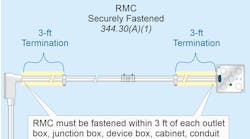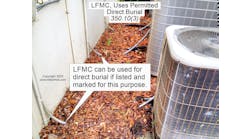Courtesy of www.MikeHolt.com
Q. What is the NEC requirement for cables and conductors transitioning from a cable tray to a raceway?
See answer below.
A. According to Sec. 392.46, a box is not required where cables or conductors are installed in a bushed raceway used for support, protection against physical damage, or where conductors or cables transition to a raceway from the cable tray (Figure).
(A) Through Bushed Conduit or Tubing. Individual conductors or multiconductor cables with entirely nonmetallic sheaths, can enter enclosures where they are terminated through nonflexible bushed conduit or tubing installed for their protection, provided they are secured at the point of transition from the cable tray and the raceway is sealed at the outer end using an approved means, so debris is prevented debris from entering the equipment through the raceway.
(B) Flanged Connections. Individual conductors or multiconductor cables with entirely nonmetallic sheaths can enter enclosures through openings associated with flanges from cable trays where the cable tray is attached to the flange and the flange is mounted directly to the equipment. The openings must be made so the conductors are protected from abrasion and must be sealed or covered to prevent debris from entering the enclosure through them.
Note: One method of preventing debris from entering the enclosure is to seal the outer end of the raceway or the opening with duct seal.
These materials are provided to us by Mike Holt Enterprises in Leesburg, Fla. To view Code training materials offered by this company, visit www.mikeholt.com/code.






